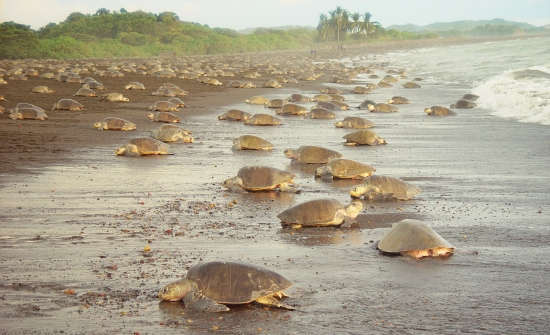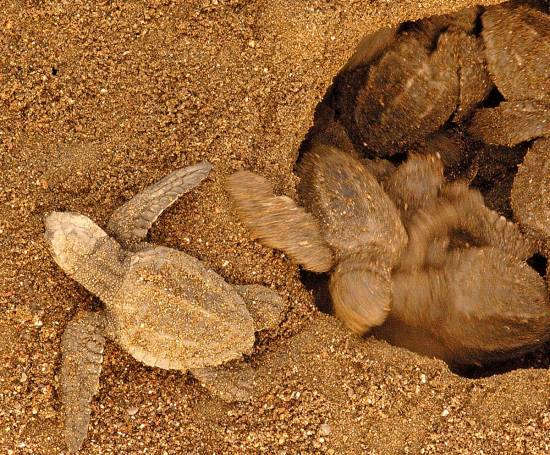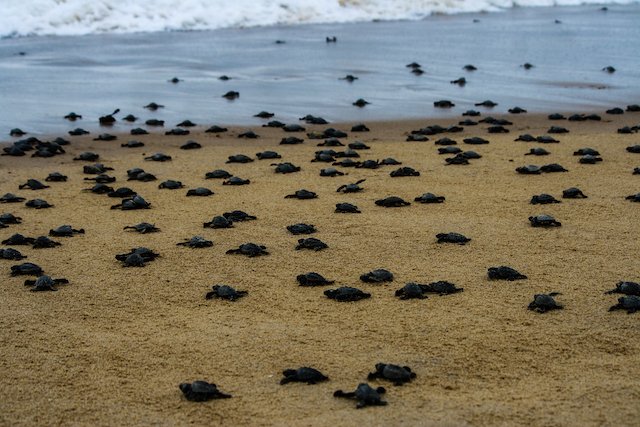Turtles hatch in Costa Rica from July to December. The hatching season usually peaks in September.
Costa Rica is a prime destination for turtle enthusiasts due to its diverse range of turtle species and nesting sites. The country’s warm, tropical climate provides the perfect conditions for turtles to lay and hatch their eggs. During the hatching season, visitors can witness the incredible sight of baby turtles making their way to the ocean under the moonlit sky.
Conservation efforts and guided tours are available to ensure the protection and preservation of these remarkable creatures. Whether you’re a nature lover or simply seeking a unique experience, witnessing turtle hatchings in Costa Rica is an unforgettable and educational adventure.

Credit: costaricaexperts.com
Factors Affecting Turtle Hatching
Turtle hatching in Costa Rica is influenced by factors like temperature, humidity, and predators. The timing of turtle hatchings varies due to these environmental conditions, ensuring the survival of the hatchlings. Predation risk is high, prompting turtles to hatch at night to increase their chances of reaching the sea safely.
Factors Affecting Turtle Hatching Turtle hatching in Costa Rica is a fascinating natural event that is influenced by several crucial factors. Understanding these factors can help in the conservation efforts of these magnificent creatures. Temperature, Nesting Depth, and Sandbox Moisture are among the key elements that play a significant role in determining the success of turtle hatching in Costa Rica.Temperature
The temperature of the sand where the turtle nests plays a critical role in determining the sex of the hatchlings. Cooler temperatures tend to produce male hatchlings, while warmer temperatures result in female hatchlings. This phenomenon, known as temperature-dependent sex determination, underscores the importance of maintaining optimal nesting conditions to ensure a balanced population of male and female turtles.Nesting Depth
The depth at which a turtle’s nest is buried in the sand is another crucial factor that can impact the hatching success. The ideal nesting depth is around 50-60 centimeters, providing a stable and protected environment for the eggs. Proper nesting depth helps shield the eggs from external disturbances and ensures a consistent temperature for successful incubation. These factors are essential considerations in the conservation and protection of turtle populations in Costa Rica. By understanding the impact of temperature, nesting depth, and sandbox moisture, conservationists and researchers can work towards creating optimal conditions for the successful hatching and survival of these remarkable creatures.Turtle Species In Costa Rica
Costa Rica is home to various turtle species that play a crucial role in the country’s ecosystem. Two prominent turtle species found in Costa Rica are Olive Ridley and Green Sea Turtles.
Olive Ridley
Olive Ridley turtles, known for their olive-green colored shells, are one of the most abundant turtle species in Costa Rica.
Green Sea Turtle
Green Sea Turtles, named after their green fat, are another common species seen along the coasts of Costa Rica.
Nesting Season In Costa Rica
The nesting season in Costa Rica is a crucial time for turtles. During this period, female turtles leave the ocean and make their way up the beaches to lay their eggs. Costa Rica is home to four different species of sea turtles, and each has its nesting season.
Peak Months
The peak months for turtle nesting season in Costa Rica vary depending on the species. The olive ridley sea turtles have the most significant nesting season, which occurs from July to December. On the other hand, the green turtle nesting season is from July to October, while the leatherback turtle season is from March to July. The hawksbill sea turtles have a more extended nesting season, which lasts from May to November.
Duration
The nesting season in Costa Rica typically lasts for several months. For olive ridley sea turtles, the nesting season lasts for six months, while the green turtle nesting season lasts for four months. The leatherback turtle nesting season lasts for around four months, while the hawksbill sea turtle nesting season can last for up to seven months.
The duration of the nesting season is critical for conservation efforts. During this time, conservationists and volunteers work tirelessly to protect the nests from predators and poachers. The eggs are carefully monitored to ensure that they hatch successfully, and the baby turtles make it safely to the ocean.
It is essential to remember that turtle nesting season is a sensitive time for these creatures. Tourists and visitors to the beaches should follow strict guidelines to ensure that they do not disturb the turtles or their nests. By doing so, we can help protect these endangered species and ensure that they continue to thrive for generations to come.

Credit: www.creescapes.com
Hatching Process
Turtles are fascinating creatures, and witnessing the hatching process of these majestic animals is a truly awe-inspiring experience. In Costa Rica, the hatching process of turtles is a natural wonder that draws visitors from around the world. Understanding the timeline and stages of the hatching process provides valuable insight into the life cycle of these remarkable reptiles.
Incubation Period
The incubation period for turtle eggs in Costa Rica typically ranges from 45 to 70 days, depending on the species. The warm sands of the nesting beaches provide the ideal environment for the eggs to develop and mature. During this time, the dedicated efforts of conservationists and volunteers ensure that the nesting sites are protected, allowing the eggs to incubate undisturbed.
Emergence
As the incubation period nears its end, the tiny turtles begin to stir within their shells, signaling the imminent emergence from the nest. Once the hatchlings emerge, they instinctively make their way to the ocean, guided by the moonlight and the natural magnetic fields. This perilous journey is a critical stage in the life of a sea turtle, as they face numerous predators and obstacles before reaching the safety of the sea.
Predation Risks For Hatchlings
When turtles hatch in Costa Rica, they face various predation risks that threaten their survival. Understanding these risks is crucial for conservation efforts. Let’s explore the natural predators and human impact on these vulnerable hatchlings.
Natural Predators
In the natural world, turtles encounter a myriad of predators that pose a threat to their survival. These predators include birds, crabs, raccoons, and snakes. These animals are known to prey on turtle hatchlings as they make their way from the nest to the sea. The vulnerability of hatchlings during this journey makes them an easy target for these natural predators.
Human Impact
Unfortunately, human activities also contribute to the predation risks faced by turtle hatchlings. Coastal development, pollution, and poaching are some of the major human impacts that threaten the survival of turtle hatchlings. These activities disrupt the natural habitat of turtles and expose them to additional dangers, leading to a decline in their population.

Credit: costaricaexperts.com
Conservation Efforts
Costa Rica is known for its abundant wildlife and stunning biodiversity. One of the most famous creatures that call this country home is the sea turtle. With five different species found along its shores, Costa Rica is a critical location for the conservation of these magnificent creatures. In this article, we will take a closer look at the conservation efforts being made in Costa Rica to protect sea turtles, with a particular focus on when turtles hatch in this beautiful country.
Protective Measures
One of the most critical conservation efforts in Costa Rica to protect sea turtles involves the implementation of protective measures on the country’s beaches. These measures include:
- Restricting access to nesting beaches during the nesting season
- Establishing protected areas where turtles can nest undisturbed
- Setting up physical barriers to protect turtle nests from predators
- Regulating artificial lighting along the beaches to prevent hatchlings from becoming disoriented and heading away from the ocean
These protective measures have been highly effective in ensuring that sea turtles have safe spaces to nest and hatch.
Community Involvement
Another critical aspect of sea turtle conservation efforts in Costa Rica is community involvement. Many local communities have recognized the importance of protecting these creatures and have taken an active role in conservation efforts. This involvement includes:
- Volunteering to patrol nesting beaches to deter poachers and predators
- Participating in beach cleanups to remove debris that can impede turtle nesting and hatching
- Providing education to tourists and locals about the importance of sea turtle conservation
- Supporting conservation organizations through donations and other means
Community involvement has been instrumental in ensuring that sea turtles have safe spaces to nest and hatch, and it has also helped to raise awareness about the importance of protecting these magnificent creatures.
In conclusion, the conservation efforts being made in Costa Rica to protect sea turtles are critical for the survival of these magnificent creatures. With protective measures in place and community involvement, we can ensure that sea turtles continue to call Costa Rica home for many generations to come.
Popular Turtle Hatchling Sites
Costa Rica is renowned for its stunning beaches where turtles come to nest and hatch their eggs.
Tortuguero National Park
Known as one of the most important nesting sites for green sea turtles, Tortuguero National Park offers a remarkable opportunity to witness these majestic creatures hatch. The park, located on the Caribbean coast, is a vital conservation area for various turtle species.
Ostional Wildlife Refuge
The Ostional Wildlife Refuge is another significant site for turtle hatchlings in Costa Rica, particularly famous for the olive ridley turtles. This refuge allows visitors to observe mass nestings known as arribadas, where thousands of turtles come ashore to lay their eggs.
Tips For Responsible Turtle Watching
When it comes to watching the incredible sight of turtle hatchings in Costa Rica, it’s crucial to do so responsibly. Following a few simple tips can ensure that your experience is not only enjoyable but also respectful to the natural environment and the turtles themselves.
Respectful Behavior
When observing turtle hatchings, it’s important to maintain a respectful distance and avoid any sudden movements or loud noises that could startle the turtles. Always follow the guidance of the local conservation authorities and avoid using flash photography, as this can disorient the hatchlings.
Guided Tours
Consider joining a guided tour led by experienced naturalists who can provide valuable insight into turtle behavior and ensure that visitors adhere to responsible viewing practices. These tours often prioritize the well-being of the turtles and offer educational opportunities for visitors.
Conclusion
In Costa Rica, turtle hatchings are a mesmerizing natural wonder that captivates visitors. The hatching season varies depending on the species, offering a unique opportunity to witness these incredible creatures embark on their journey to the sea. Experience the magic of turtle hatchings in Costa Rica firsthand.






Leave a Reply